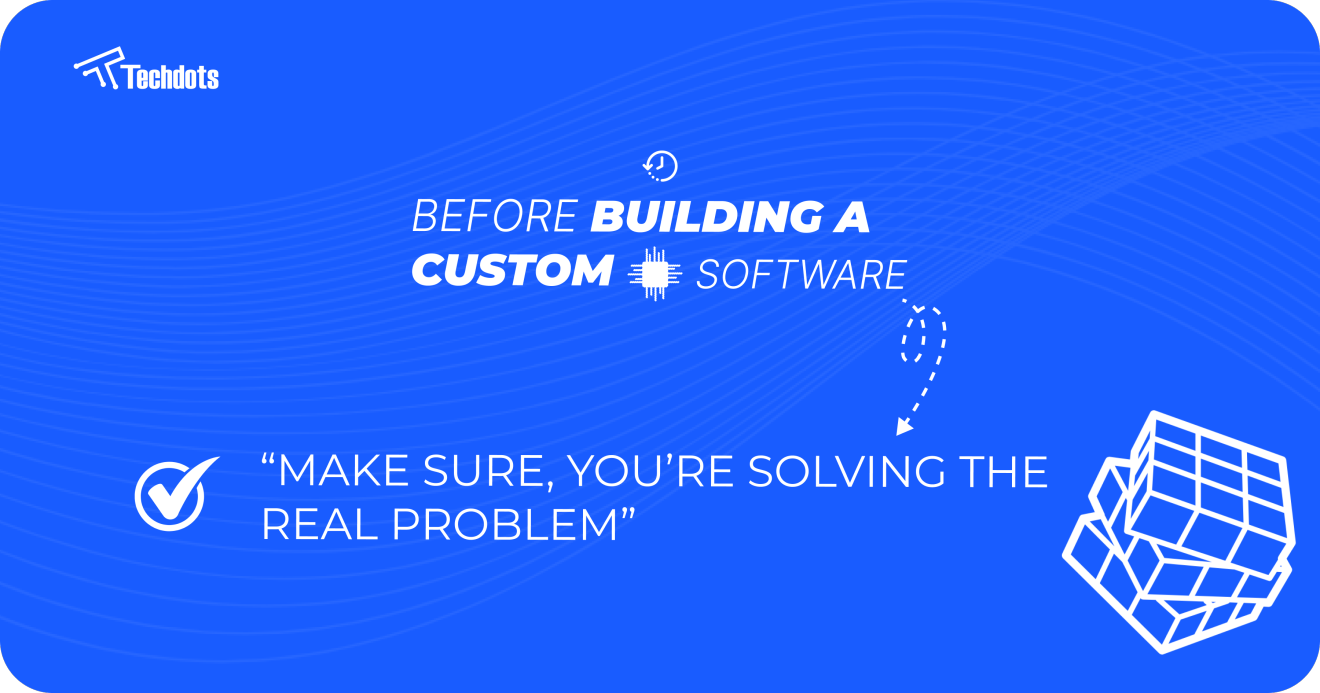




Are You Building Software That Nobody Wants?
You spend months and thousands of dollars building custom software for your business. The day finally comes to launch it. But instead of celebrating, you watch your team continue using their old tools and workarounds. Sound familiar?
You're not alone. According to PM360 Consulting, 66% of technology projects end in partial or total failure, and it's rarely because of bad coding. The real problem? Most companies build solutions for problems that don't actually exist.
Custom software development can transform your business when done right. Studies from Moldstud show that 70% of employees prefer customized tools, which can boost productivity by up to 25%. The custom software development market is booming, with Precedence Research projecting it will reach over $50 billion in 2025.

But here's the thing: before you write a single line of code, you need to make sure you're solving a real problem. Research from TechTarget reveals that many projects are "doomed to fail because they are initiated to solve the wrong problem."
Let's explore how to validate your custom software ideas and avoid costly mistakes that plague the industry.
Most companies start custom software development with good intentions, but make critical mistakes from day one. Understanding these pitfalls can save you from joining the ranks of failed projects.
Too many teams build features because someone in leadership had a "great idea" during a meeting. They skip the research and jump straight to coding, relying on gut feelings rather than data.
According to TechTarget, projects often fail when decision-makers rely on subjective judgments and limited data instead of real user requirements. This "solution-first" mindset creates software that completely misses the mark for actual users.
Real-world impact: Teams end up building pet features that executives pushed without evidence, leading projects astray from solving genuine business problems.
Some companies decide to replace existing tools without understanding how their teams currently work. They rush to automate processes without mapping out current workflows first.
Research from Sunnet found that when an underlying business process is immature or not well-defined, implementing software for it will simply "manage the wrong process" and fail to deliver expected results.
The consequence: You risk automating broken or inefficient processes, making problems worse instead of better. Software should serve your business workflow, not define it from thin air.
Many projects start with vague goals like "improve productivity" or "modernize our systems." Without specific, measurable targets, teams build software that technically works but doesn't deliver results.
Data from Moldstud shows that 39% of projects fail due to unclear objectives. As one project management expert from PM360 Consulting warns: "Before even beginning a project, be certain you can define success, else you'll meander and never reach agreement."
These mistakes lead to predictable and expensive problems:
Even "working" software gets ignored if it doesn't solve real problems. A project can meet all its requirements yet still fail if end users reject it. This happens when software is built in isolation, without user input.
Teams add "cool" features that sound good on paper but aren't used in practice. The famous Standish Group study, referenced by Mountain Goat Software, found that 64% of features in software are rarely or never used by anyone.

U.S. companies spend an estimated $260 billion annually on unsuccessful software projects. Failed or underused software isn't just an IT problem—it's a massive business cost.
Large IT projects deliver only about 44% of expected value on average, meaning 56% of anticipated benefits never materialize.
The good news? These problems are completely avoidable if you follow the right custom software development process.
Before thinking about what to build, understand what's actually broken in your business. Don't start with solutions—start with problems. This problem-first approach ensures you solve real, high-impact pain points rather than creating fancy tools that don't move the needle.
Dig deep into your business operations by asking:
Avoid abstract or presumed problems. Instead, pinpoint pain points in concrete terms:
Instead of: "We need a mobile app because everyone has smartphones." Try: "Our field service reps enter the same data in two different systems, wasting 5 hours per week."
Instead of: "We should build what our competitor built. Try: "Our analysts spend 2 days every month combining data from 5 sources for one report."
The best insights come from employees who feel the pain daily:
Often, this means talking to people beyond the executive level—those actually doing the work understand the nuances of current processes.
Support your problem statements with concrete data when possible:
Why this matters: Research from Moldstud shows that organizations with clear, well-defined goals see 30% higher project success rates than those with vague objectives. Valtira notes that a lack of clear requirements is consistently a top cause of project failure.
Once you know the problem, understand the process around it. Before designing software features, map out how work currently gets done. This creates a blueprint that developers and stakeholders can reference throughout the project.
This exercise often reveals problems you didn't know existed. You might discover:
Sometimes you'll realize the process itself needs fixing before you add software to it. There's no point automating a broken process—you'll just get bad results faster.
Healthcare.gov case study: According to Sunnet, even Healthcare.gov's infamous failed launch in 2013 was partly attributed to a poor understanding of processes and user journey, leading to an over-budget system that initially crashed with only 6 users on day one.
Workflow mapping can be as straightforward as:
The goal is to create a guide that developers can reference: "The software needs to take output from Step 3 and automatically notify the person responsible for Step 4."
Bottom line: The Project Management Institute found that poor upfront planning is linked to 33% of project failures. When software follows a well-defined workflow, it fits users' needs naturally because it mirrors their real-world tasks.
The people who will actually use your software know best what it should do. One of the biggest mistakes in custom software development is designing in isolation, based only on what management thinks users need.
Conduct discovery interviews with different types of users:
Ask them to walk you through their current process and explain their frustrations. You'll almost always uncover insights or edge cases that hadn't occurred to higher-ups.
Shadow employees for a day, if possible. Watch them work in their natural environment. See the multiple browser tabs, sticky notes, and copy-pasting between systems. This builds empathy and sparks ideas for what your software needs to handle.
Share early prototypes or even paper mockups and get feedback. It's much cheaper to change course based on user input during design than after coding is complete.
The data strongly supports user involvement in custom software development:
When users feel heard and see their input reflected in the software, they're more likely to embrace it. Conversely, no amount of executive pressure can force adoption of software that makes someone's job harder.
Release software in small increments and gather feedback frequently. This "release early and often" approach helps you validate assumptions before committing your entire budget.
Early feedback might reveal that a "crucial" feature is rarely used, while a small tweak elsewhere could dramatically improve usability. By the time you launch, you'll have a group of power users ready to champion the new tool rather than resist it.
It's tempting to get excited about features and create a wish list of capabilities. But success isn't measured by how many features you build—it's measured by the business outcomes they enable.
Center discussions around value and results:
Instead of feature lists, define success as:
Each proposed feature should have a clear purpose. Ask: "Which outcome does this support?" If you can't answer, think twice before adding it.
This approach helps prevent feature bloat and keeps projects lean and focused on delivering value. Every feature should trace back to solving the specific problem you identified in Step 1.
Mountain Goat Software references the sobering statistic that 64% of software features are rarely or never used. Every unused feature represents wasted time and money that could have been spent elsewhere.
Even when projects deliver all planned requirements, they might still miss the mark on business value. The ResearchGate study shows that large IT projects deliver only about 44% of the expected value on average.
Sometimes you don't need custom software for every part of your solution. For generic needs (like CRM or basic inventory tracking), existing tools might work better:
Ask yourself: "Does this feature give us enough unique value to justify custom development, or could we meet the need with an existing tool?"
Build a Minimum Viable Product (MVP)—the simplest version that delivers your core outcome. Then iterate based on real feedback.
Benefits of the MVP approach:
Thorough validation requires time and expertise that many companies lack internally. A quality custom software development partner will actually "slow you down" initially to prevent costly mistakes later. They understand that rushing into development is a false economy.
At Techdots, we guide clients through comprehensive discovery before building anything. We help distinguish real problems from symptoms, evaluate whether custom software is truly needed, and identify high-impact features for initial development.
According to WeblineIndia, thorough discovery can reduce development costs by up to 30% while significantly improving success rates.
External partners bring objective perspectives and experience from multiple projects. They conduct market research, assess existing solutions, and bring in UX experts when needed.
Emergent Software notes that clients rarely emerge from discovery with their original idea unchanged—and that's beneficial, as it means the concept has been refined and aligned with real needs.
Before committing to custom software development, validate four key areas:
Problem Validation: Articulate the specific business problem in one sentence, gather supporting data (time/money lost), and confirm it's a real issue by talking to people experiencing it daily.
Solution Validation: Map current workflows, understand all stakeholders, consider existing tools, and verify custom software is the most cost-effective approach.
User Validation: Interview different user types, understand their current workarounds, gather feedback on early concepts, and ensure users are genuinely excited about the proposed solution.
Success Validation: Define measurable success criteria, identify which KPIs will improve and by how much, establish ROI measurement methods, and secure executive alignment on goals.
If you can't address most of these areas confidently, you need more validation before proceeding with development.
Custom software development isn't about building faster—it's about building smarter. The most successful projects solve clear, real problems and deliver meaningful business results. Before investing in code, ensure you're solving the right problem with a deep understanding of your workflow and users.
Ready to validate your custom software idea properly? At Techdots, we specialize in custom software solutions that deliver real business value. Let's discuss your project and ensure you're building the right solution for the right reasons from day one.

Techdots has helped 15+ founders transform their visions into market-ready AI products. Each started exactly where you are now - with an idea and the courage to act on it.
Techdots: Where Founder Vision Meets AI Reality
Book Meeting